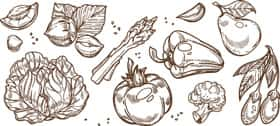
The word inflammation comes from the Latin word inflammationem, which means “a setting on fire.” Certainly anyone who has experienced the feelings of heat, redness, swelling, pain and burning that makes the origin of this word an accurate description. But what exactly is inflammation and how can it hurt—as well as help—your body?
At its most basic definition, inflammation is the body’s natural reaction to an injury or infection—its attempt to heal itself. So, while we generally have negative connotations to the word, we are nevertheless fortunate that the body has this built-in immune system in place to recognize damaged cells, irritants and pathogens to heal an injury or fight an infection. Though inflammation may be uncomfortable, it is the body’s biological response to remove a harmful affect on the body. Without it, infections, wounds, and other damage to tissue couldn’t heal.
 “Inflammation overall is an immune response,” says Kim Kulp, registered dietician at Santa Rosa Memorial Hospital. “It’s your body’s way of trying to fix any foreign invader, or some damage to the body,” adds Kulp, who is also the owner of her own private practice, Health Tastes Great, seeing patients in both Novato and Mill Valley.
“Inflammation overall is an immune response,” says Kim Kulp, registered dietician at Santa Rosa Memorial Hospital. “It’s your body’s way of trying to fix any foreign invader, or some damage to the body,” adds Kulp, who is also the owner of her own private practice, Health Tastes Great, seeing patients in both Novato and Mill Valley.
Generally, once the injury or infection is healed, the inflammation should stop. This normal process is usually identified as acute inflammation. However, when inflammation does not dissipate, but lingers in the body long term it becomes chronic inflammation and can lead to a variety of other diseases.
“Acute and chronic [inflammation] is just a descriptor of the chronicity, or the time, that the inflammation has taken place in your body,” says Michael Yang, M.D., Santa Rosa-based Summit Pain Alliance, a leader in pain management in Northern California, which provides cutting edge technologies, pain management therapies, and advancements in pain relief, both acute and chronic. “Generally, in the field of pain management, we demarcate that at about six months. It’s not an exact science, but we have to draw the line somewhere, so it’s generally accepted that anything beyond six months is considered chronic pain. Inflammation is exactly that. So, if you’ve had an inflammatory response in a certain body part and if it’s been there longer than six months, it’s considered chronic.”
A silent precursor to disease
Unfortunately, chronic inflammation is not only uncomfortable or painful, but more and more research shows a link to a variety of diseases. According to Harvard Medical School, “…research on inflammation has created a shift in medical thinking. For two millennia, it has been viewed mainly as a necessary, even beneficial, response to illness or injury. But now both observational studies and laboratory research are indicating that inflammation can be more of a bane than boon, the common, causative factor in many diseases.” Research now shows inflammation may be a common underlying cause of many major degenerative diseases, including coronary artery disease, diabetes, cancer and Alzheimer’s.
 “Inflammation itself can be harmful to the body, even though it’s the body’s way of bringing in the healing factors,” says Yang. “If it’s chronic and it’s constantly bringing in these inflammatory cytokines that cause swelling and redness and pain, all of that is just the body trying to heal itself. But if it’s there on a chronic basis, that in itself can also cause deterioration. In medical terms, anything with –itis at the end of it means inflammation of whatever is in that base word. So, arthritis is inflammation of the joints, appendicitis is inflammation of the appendix, and bronchitis is inflammation of the bronchials. But of course, chronic bronchitis is terrible for you and arthritis—as it gets worse—causes giant swollen joints, which can cause terrible deformities. Chronic inflammation can cause a lot of damage to your body.”
“Inflammation itself can be harmful to the body, even though it’s the body’s way of bringing in the healing factors,” says Yang. “If it’s chronic and it’s constantly bringing in these inflammatory cytokines that cause swelling and redness and pain, all of that is just the body trying to heal itself. But if it’s there on a chronic basis, that in itself can also cause deterioration. In medical terms, anything with –itis at the end of it means inflammation of whatever is in that base word. So, arthritis is inflammation of the joints, appendicitis is inflammation of the appendix, and bronchitis is inflammation of the bronchials. But of course, chronic bronchitis is terrible for you and arthritis—as it gets worse—causes giant swollen joints, which can cause terrible deformities. Chronic inflammation can cause a lot of damage to your body.”
Alarmingly, some inflammation that occurs deep inside the body, such as in an internal organ where there may not be any sensory nerve endings, may not have any visible or noticeable signs that make it immediately obvious what is happening in the body.
“Eventually something will go wrong,” warns Kulp. “You’re not going to be feeling well, or there will be more fatigue, or you might have some symptoms of these diseases. There isn’t just one sign of inflammation.”
Other symptoms that may eventually become present include abdominal or chest pain, fever, joint pain, or a rash, but some of these indicators can seem mild enough to not necessarily seek medical attention. However, today there are certain blood tests that show if an inflammatory process is going on.
“There are parts of the body that have little sensation,” says Yang. “You can have inflammation that is just circulating in the blood stream. You can have inflammation of your bowels, like irritable bowel syndrome and chronic ulcerative colitis—those are bowel inflammations that can wreak havoc on the body, but you don’t feel it until you have a stomach cramp. But the inflammation is there all the time.”
A look at the source
There are several possible causes of chronic inflammation. Just as some foods can minimize inflammation, food allergies or sensitivities, or a poor diet can cause immune systems to overreact. Other causes can include constant psychological, emotional or physical stress, which raises your level of cortisol, creating inflammation. In addition, environmental toxins are linked to inflammation-induced diseases as well as other poor lifestyle choices such as inactivity, lack of sleep and dehydration.
“With anything in the gut, it’s generally diet,” says Yang. “There is literature that suggests it could be stress-induced. There is literature that there may be a component of a genetic factor, but that is more of an unknown. What we know for certain is that a big part of it has to do with diet and a big part of it has to do with your emotional state as well.”
“You are what you eat,” is a phrase that’s been used for years and still makes sense. What we put into our bodies can help us or hurt us.
“When we eat food it is distributed throughout our whole body—through our intestinal tract, into our blood, into our cells,” says Tawnya Shine-Dorn, registered dietician at Queen of the Valley Medical Center in Napa. “We have seen with diet research, nutrients can turn on and off cursors in our DNA. If you’re not giving your internal body the right environment via the food you’re consuming, you absolutely will have inflammation and therefore, it can cause some of these chronic diseases.”
Preventing and minimizing inflammation
Once chronic inflammation has taken root in the body, there are steps that can be taken to reduce it and its far-reaching effects. Certainly, as in most cases, the quicker the inflammation is identified and treated, the more any other damage can be minimized, especially before it becomes chronic. Some patients have had success with alternative treatments such as acupuncture and herbal supplements, and others have had success with traditional western medicinal procedures such as steroids, though these are generally not recommended for long-term use.
“Treatment for inflammation is very different in different parts of the body,” says Yang. “For a lot of conditions you could do a systemic steroid like prednisone. However, systemic steroids have a ton of side affects and that’s not good for you either. You can do it for the short term if you can get it under control, but you don’t want to use prednisone for chronic inflammation. Over time, the prednisone has worse side affects than inflammation itself. I inject steroids into the spine when people have inflamed nerve roots in the spine, such as sciatica, for example. That helps take away the inflammation of that nerve and they don’t get sciatica anymore. It’s a single shot done twice a year that takes away the inflammation, and it’s not a constant, persistent exposure to steroids.”
Yang adds, however, that looking at prevention is a difficult question to answer since there are thousands of different types of inflammation and there simply is not one solution that can treat all of them.
 For Dorn, changing not only our diets, but behaviors and lifestyle can make a significant impact in lowering inflammation, thereby reducing your risk for other diseases as well.
For Dorn, changing not only our diets, but behaviors and lifestyle can make a significant impact in lowering inflammation, thereby reducing your risk for other diseases as well.
“Changing behavior can influence the way we eat the next day,” says Dorn. “I usually start talking to my clients about their sleep patterns—making sure they’re getting adequate sleep. If they’re not, it will affect their nutrition and therefore affect their whole, overall body system. People who are getting inadequate sleep wake up and crave sugar because their body needs a quick jolt of energy.”
In addition, people who don’t get enough sleep often tend to not drink enough water the next day and research has shown that getting adequate amounts of water is vital to the function of our cells and body systems.
At the very least, people should attempt to pay close attention to their bodies. Realizing when there are changes or subtle clues can help diminish inflammation and other long-term damage before it’s too late.
“The symptoms of inflammation is the body’s way of telling you something may be going wrong,” says Yang. “Being aware and in tune with what your body is telling you is important because it’s your body and you’re going to be the first person to be aware that something’s wrong. Your doctor is not going to pick up on the fact that you have inflammation somewhere, unless you’re doing blood tests every month. So, being in tune with what your body is saying to you allows you to react to it a lot quicker, and you can bring it up to your doctor whenever you notice a problem. Alerting your doctor about what you feel is not going right in your body is an important first step.”
The Link Between Gluten & Inflammation
There has been a lot of buzz in the media over the last several years, regarding gluten and how it may cause inflammation in the body. While refined, processed white breads and pastas have shown to increase inflammation and slow the body’s ability to absorb nutrients, whole grain carbohydrates are not only tolerable by most people in the population, but deemed healthy by experts.
“There is nothing inflammatory about gluten unless of course you have a health issue such as Celiac disease,” says Kulp. “Celiac disease is an autoimmune disease where when you eat gluten it attacks your small intestine and those people have to have a gluten free diet for life. At this point it’s about 1 percent of the population that has Celiac disease, but a lot of other people are jumping on this ‘gluten is bad for you’ bandwagon when it just isn’t warranted. Gluten itself is a protein. It is not an unhealthy thing unless it bothers you. Many people who think they’re sensitive to gluten may be sensitive to something else they don’t know because you have to work with a professional to find it. There are no tests at this time that can tell you if you’re gluten sensitive.”
Indeed, many gluten free products, while a great option and alternative for those who have Celiac disease, are not necessarily a better choice for those who don’t need to avoid gluten, as many are highly refined and processed with a lot of additives.
Kulp urges individuals to visit farmers markets and continue to seek out a variety of seasonal, brightly colored fruits and vegetables. Different colored foods contain different antioxidants and phytonutrients, so the bigger the variety on your plate the more health benefits you will have. Also, she advises to get most of your nutrients from food, rather than relying on vitamins or supplements to make up what may be lacking in your diet.
“Food always first,” says Kulp. “Our bodies were made to digest, absorb and work with food, not the specific nutrients. To get barraged with a single nutrient that wouldn’t be naturally occurring, our bodies don’t always know what to do with that. You’re not getting the fiber, you’re not getting all the other vitamins that go together with eating that food. Fiber, we’re learning, is an incredibly important nutrient.”
The Anti-Inflammatory Diet
 Both doctors and dieticians tend to agree that one of the best ways to prevent or reduce inflammation is to eat an anti-inflammatory diet. This involves eating certain foods and avoiding others to minimize the symptoms of chronic inflammation and its related diseases. While there is no one-size-fits-all approach, some foods have been shown to increase inflammation and others have been shown to reduce it.
Both doctors and dieticians tend to agree that one of the best ways to prevent or reduce inflammation is to eat an anti-inflammatory diet. This involves eating certain foods and avoiding others to minimize the symptoms of chronic inflammation and its related diseases. While there is no one-size-fits-all approach, some foods have been shown to increase inflammation and others have been shown to reduce it.



